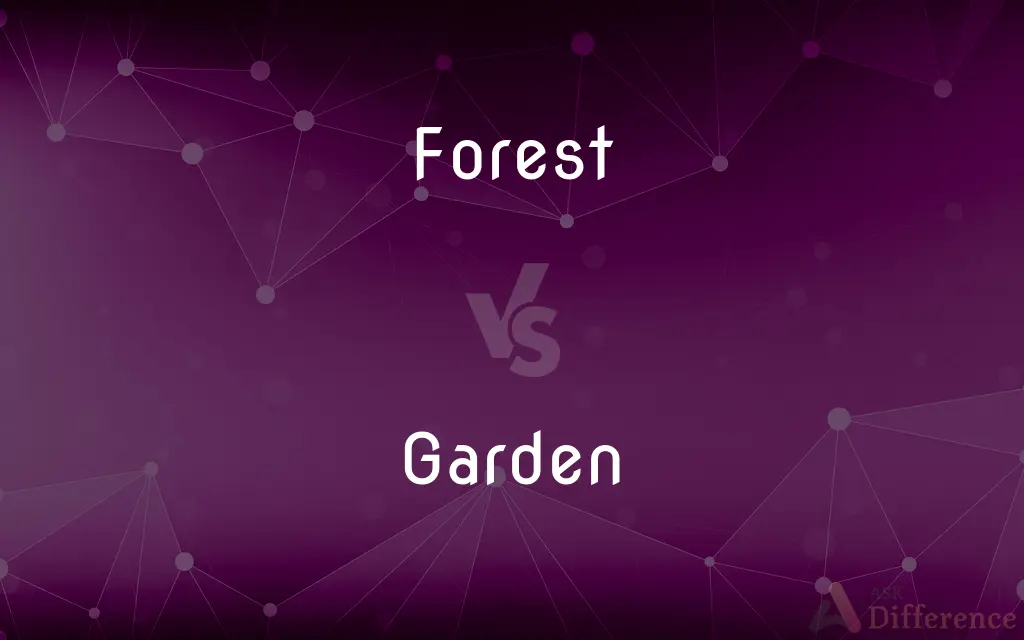Forest vs. Garden — What's the Difference?
By Urooj Arif & Maham Liaqat — Updated on March 12, 2024
Forests are large, natural ecosystems dominated by trees, while gardens are smaller, cultivated areas designed for aesthetic, culinary, or leisure purposes.

Difference Between Forest and Garden
Table of Contents
ADVERTISEMENT
Key Differences
A forest is a vast, natural area covered predominantly by trees and underbrush, hosting a diverse range of flora and fauna. It functions as a critical ecosystem, providing habitat for wildlife, contributing to the Earth's oxygen supply, and playing a significant role in climate regulation. In contrast, a garden is a planned space, often much smaller than a forest, where plants are cultivated for various purposes, including beauty, food, or recreation. Gardens are human-made and reflect careful planning and maintenance to achieve desired outcomes.
Forests are characterized by their self-sustaining nature, with ecological processes such as nutrient cycling, photosynthesis, and natural succession occurring without human intervention. They can vary greatly in size, type, and biodiversity, depending on factors like climate, geography, and the age of the forest. Meanwhile, gardens are defined by human intervention, relying on careful selection of plants, landscaping, and maintenance practices like watering, pruning, and pest control to thrive.
The diversity of life in forests is unparalleled, with millions of species of plants, animals, fungi, and microorganisms interacting in complex food webs. This biodiversity is essential for ecosystem resilience and provides numerous ecosystem services, including water purification, soil conservation, and carbon sequestration. Gardens, although more limited in scope, can also support biodiversity, particularly when they include a variety of plants and habitats that attract pollinators and other wildlife.
Forests often serve broader environmental and social functions, such as timber production, recreation, and spiritual significance for many cultures. They are vital for sustaining the planet's health and human well-being. Gardens, on a smaller scale, contribute to environmental health by promoting green spaces in urban areas, enhancing air and water quality, and providing spaces for relaxation, education, and community building.
The distinction between forests and gardens also lies in their aesthetic and experiential qualities. Forests offer a sense of wilderness and natural beauty, allowing for immersive experiences in nature. Gardens, with their designed landscapes and plant arrangements, provide a curated beauty that reflects cultural and personal preferences, often serving as peaceful retreats or spaces for creative expression.
ADVERTISEMENT
Comparison Chart
Definition
Large area dominated by trees and natural vegetation.
Planned space for cultivating plants.
Size
Vast, can span thousands of square miles.
Smaller, ranging from a few square feet to several acres.
Biodiversity
High, with complex ecosystems.
Varies, can be high in diverse gardens.
Human Intervention
Minimal, ecosystems are self-sustaining.
High, requires planning and maintenance.
Purpose
Habitat, oxygen production, climate regulation.
Aesthetic, culinary, recreational.
Compare with Definitions
Forest
A large area covered with dense tree growth and underbrush.
The Amazon rainforest is one of the world's most vital ecological resources.
Garden
A planned space for growing plants for various purposes.
The botanical garden features an extensive collection of tropical plants.
Forest
Home to diverse flora and fauna.
Tropical forests harbor over half of the world's species.
Garden
Serves as habitat for pollinators and urban wildlife.
Urban gardens with native plants attract bees, butterflies, and birds.
Forest
Natural ecosystems with minimal human intervention.
Old-growth forests are prized for their biodiversity and ecological value.
Garden
Reflects human design and aesthetics.
Japanese Zen gardens are known for their minimalist beauty and tranquility.
Forest
Offer recreational and spiritual experiences.
Many people find solace and connection in the serene environment of a forest.
Garden
Often found in residential or public areas.
The city park's rose garden is a popular spot for relaxation and events.
Forest
Vital for climate regulation and oxygen production.
Boreal forests act as significant carbon sinks.
Garden
Can be dedicated to vegetables, flowers, or leisure.
Community vegetable gardens provide fresh produce and green space in urban areas.
Forest
A forest is an area of land dominated by trees. Hundreds of definitions of forest are used throughout the world, incorporating factors such as tree density, tree height, land use, legal standing and ecological function.
Garden
A garden is a planned space, usually outdoors, set aside for the display, cultivation, or enjoyment of plants and other forms of nature, as an ideal setting for social or solitary human life. The single feature identifying even the wildest wild garden is control.
Forest
A large area covered chiefly with trees and undergrowth
A pine forest
A large tract of forest
Garden
A piece of ground adjoining a house, in which grass, flowers, and shrubs may be grown
Children love playing in the garden
A garden gate
Forest
A large number or dense mass of vertical or tangled objects
A forest of high-rise apartments
Garden
A large public hall
Madison Square Garden
Forest
Cover (land) with forest; plant with trees
A forested hillside
Garden
Cultivate or work in a garden
She wrote books, kept journals, and gardened
Forest
A growth of trees and other plants covering a large area.
Garden
A plot of land used for the cultivation of flowers, vegetables, herbs, or fruit.
Forest
A large number of objects bearing a similarity to such a growth, especially a dense collection of tall objects
A forest of skyscrapers.
Garden
An arrangement of living material that is cultivated for food, as a fungus garden maintained by ants.
Forest
A defined area of land formerly set aside in England as a royal hunting ground.
Garden
Often gardens Grounds laid out with flowers, trees, and ornamental shrubs and used for recreation or display
Public gardens.
A botanical garden.
Forest
To plant trees on or cover with trees.
Garden
A yard or lawn.
Forest
A dense uncultivated tract of trees and undergrowth, larger than woods.
Garden
A fertile, well-cultivated region.
Forest
Any dense collection or amount.
A forest of criticism
Garden
An open-air establishment where refreshments are served.
Forest
(historical) A defined area of land set aside in England as royal hunting ground or for other privileged use; all such areas.
Garden
A large public auditorium or arena.
Forest
(graph theory) A graph with no cycles; i.e., a graph made up of trees.
Garden
To cultivate (a plot of ground) as a garden.
Forest
A group of domains that are managed as a unit.
Garden
To furnish with a garden.
Forest
The colour forest green.
Garden
To plant or tend a garden.
Forest
(transitive) To cover an area with trees.
Garden
To work as a gardener.
Forest
An extensive wood; a large tract of land covered with trees; in the United States, a wood of native growth, or a tract of woodland which has never been cultivated.
Garden
Of, suitable to, or used in a garden
Garden tools.
Garden vegetables.
Forest
A large extent or precinct of country, generally waste and woody, belonging to the sovereign, set apart for the keeping of game for his use, not inclosed, but distinguished by certain limits, and protected by certain laws, courts, and officers of its own.
Garden
Provided with open areas and greenery
A garden community.
Forest
Of or pertaining to a forest; sylvan.
Garden
Garden-variety.
Forest
To cover with trees or wood.
Garden
An outdoor area containing one or more types of plants, usually plants grown for food or ornamental purposes.
A vegetable garden
A flower garden
Forest
The trees and other plants in a large densely wooded area
Garden
(in the plural) Such an ornamental place to which the public have access.
You can spend the afternoon walking around the town gardens.
Forest
Land that is covered with trees and shrubs
Garden
(attributive) Taking place in, or used in, such a garden.
A garden party;
A garden path;
A garden spade
Forest
Establish a forest on previously unforested land;
Afforest the mountains
Garden
The grounds at the front or back of a house.
This house has a swimming pool, a tent, a swing set and a fountain in the garden.
We were drinking lemonade and playing croquet in the garden.
Our garden is overgrown with weeds.
Garden
(cartomancy) The twentieth Lenormand card.
Garden
(figuratively) A cluster; a bunch.
Garden
(slang) Pubic hair or the genitalia it masks.
Garden
To grow plants in a garden; to create or maintain a garden.
I love to garden — this year I'm going to plant some daffodils.
Garden
Of a batsman, to inspect and tap the pitch lightly with the bat so as to smooth out small rough patches and irregularities.
Garden
Common, ordinary, domesticated.
Garden
A piece of ground appropriated to the cultivation of herbs, fruits, flowers, or vegetables.
Garden
A rich, well-cultivated spot or tract of country.
I am arrived from fruitful Lombardy,The pleasant garden of great Italy.
Garden
To lay out or cultivate a garden; to labor in a garden; to practice horticulture.
Garden
To cultivate as a garden.
Garden
A plot of ground where plants are cultivated
Garden
The flowers or vegetables or fruits or herbs that are cultivated in a garden
Garden
A yard or lawn adjoining a house
Garden
Work in the garden;
My hobby is gardening
Common Curiosities
Can a garden be part of a forest?
Yes, gardens can be established within forests, often as part of conservation efforts, educational programs, or for aesthetic purposes, blending the wildness of the forest with cultivated beauty.
How do forests contribute to environmental health?
Forests contribute by supporting biodiversity, regulating climate, producing oxygen, and offering crucial ecosystem services like water purification and soil conservation.
What role do gardens play in urban areas?
In urban areas, gardens enhance the quality of life by providing green spaces, improving air and water quality, supporting biodiversity, and offering recreational and educational opportunities.
What is the main difference between a forest and a garden?
The main difference lies in their size, level of human intervention, and purpose, with forests being large, natural ecosystems and gardens being smaller, cultivated areas.
How can gardens support biodiversity?
Gardens support biodiversity by including a variety of plant species that attract and sustain pollinators, birds, and other wildlife, contributing to ecological balance even in urban settings.
Are all forests protected from development?
Not all forests are protected; many face threats from deforestation, development, and climate change, highlighting the importance of conservation efforts to preserve these vital ecosystems.
How do forests affect the global climate?
Forests play a crucial role in regulating the Earth's climate by absorbing carbon dioxide during photosynthesis, thus acting as carbon sinks and reducing the greenhouse effect.
What is deforestation, and why is it a concern?
Deforestation is the clearing or thinning of forests by humans, leading to loss of biodiversity, disruption of ecosystems, and contributing to climate change and global warming.
How do forests contribute to the water cycle?
Forests contribute to the water cycle by absorbing rainwater, which then evaporates from leaves in a process called transpiration, and by filtering and regulating the flow of water bodies.
What types of forests are there?
Forest types include tropical rainforests, temperate forests, boreal forests, and others, each characterized by distinct climates, flora, and fauna.
Can gardening be considered an environmental conservation activity?
Yes, when practiced sustainably, gardening can contribute to environmental conservation by promoting native plant species, supporting pollinators, and reducing ecological footprints.
What are some sustainable gardening practices?
Sustainable gardening practices include using organic fertilizers, composting, conserving water, planting native species, and practicing integrated pest management.
What role do gardens play in mental health?
Gardens provide therapeutic benefits, reducing stress, anxiety, and depression, and promoting relaxation, well-being, and a sense of connection to nature.
What is the importance of soil in gardens?
Soil health is fundamental in gardens as it provides essential nutrients, water, and support for plant roots, influencing plant growth, yield, and overall garden health.
Can forests help prevent natural disasters?
Yes, forests can mitigate natural disasters by stabilizing soil, reducing erosion, absorbing rainfall, and acting as barriers against floods, landslides, and hurricanes.
How can I attract wildlife to my garden?
Planting native species, providing water sources, creating habitats like birdhouses and insect hotels, and avoiding pesticides can make gardens more attractive to wildlife.
Share Your Discovery

Previous Comparison
Major vs. Captain
Next Comparison
Devoted vs. ReasonableAuthor Spotlight
Written by
Urooj ArifUrooj is a skilled content writer at Ask Difference, known for her exceptional ability to simplify complex topics into engaging and informative content. With a passion for research and a flair for clear, concise writing, she consistently delivers articles that resonate with our diverse audience.
Co-written by
Maham Liaqat












































